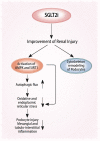The Off-Target Effects, Electrolyte and Mineral Disorders of SGLT2i
- PMID: 32549243
- PMCID: PMC7355461
- DOI: 10.3390/molecules25122757
The Off-Target Effects, Electrolyte and Mineral Disorders of SGLT2i
Abstract
The sodium-glucose cotransporter 2 inhibitors (SGLT2i) are a relatively new class of antidiabetic drugs that, in addition to emerging as an effective hypoglycemic treatment, have been shown to improve, in several trials, both renal and cardiovascular outcomes. In consideration of the renal site of action and the associated osmotic diuresis, a negative sodium balance has been postulated during SGLT2i administration. Although it is presumable that sodium and water depletion may contribute to some positive actions of SGLT2i, evidence is far from being conclusive and the real physiologic effects of SGLT2i on sodium remain largely unknown. Indeed, no study has yet investigated how SGLT2i change sodium balance in the long term and especially the pathways through which the natriuretic effect is expressed. Furthermore, recently, several experimental studies have identified different pathways, not directly linked to tubular sodium handling, which could contribute to the renal and cardiovascular benefits associated with SGLT2i. These compounds may also modulate urinary chloride, potassium, magnesium, phosphate, and calcium excretion. Some changes in electrolyte homeostasis are transient, whereas others may persist, suggesting that the administration of SGLT2i may affect mineral and electrolyte balances in exposed subjects. This paper will review the evidence of SGLT2i action on sodium transporters, their off-target effects and their potential role on kidney protection as well as their influence on electrolytes and mineral homeostasis.
Keywords: CKD; CKD-MBD; SGLUTi; diabetic kidney disease.
Conflict of interest statement
Authors declare no conflict of interest.
Figures




References
-
- Cavender M.A., Steg P.G., Smith S.C., Eagle K., Ohman E.M., Goto S., Kuder J., Im K., Wilson P., Bhatt W.D.L., et al. Impact of diabetes mellitus on hospitalization for heart failure, cardiovascular events, and death: Outcomes at 4 years from the reduction of atherothrombosis for continued health (reach) registry. Circulation. 2015;132:923–931. doi: 10.1161/CIRCULATIONAHA.114.014796. - DOI - PubMed
Publication types
MeSH terms
Substances
LinkOut - more resources
Full Text Sources

